The Illuminators
The Illuminators
Although much has been written about both the beauty and tribulations of winter, Sinclair Lewis’s observation may be the most succinct: “Winter is not a season, it’s an occupation.”
Once winter settles in—whatever your geographic latitude—there is no hastening its withdrawal. And while the season often overstays its welcome, there are myriad delights to be enjoyed during the shortened days—such as the guilt-free comfort of staying home and reading a book, cooking, crocheting, or binge-watching some delicious, if nutritionally bereft, streaming series.
That said, the increased darkness can take its toll, especially after holiday decorations are stashed and the novelty of snow or rain has settled into the endless dull grays and browns of winter. Light is a powerful antidote to maladies associated with midwinter darkness. With that in mind, we’ve gathered together lamps that not only provide illumination but also proffer pleasure through their handcrafted approaches to upping the wattage. For all of these artists and makers, lighting is one aspect of a design practice that seeks to transform our interior landscapes. Whether wrought from glass, meerschaum, ceramic, metal, gypsum—or yes, dung—each of these singular fixtures stares down the darkness with poetic verve, while presaging brighter days.
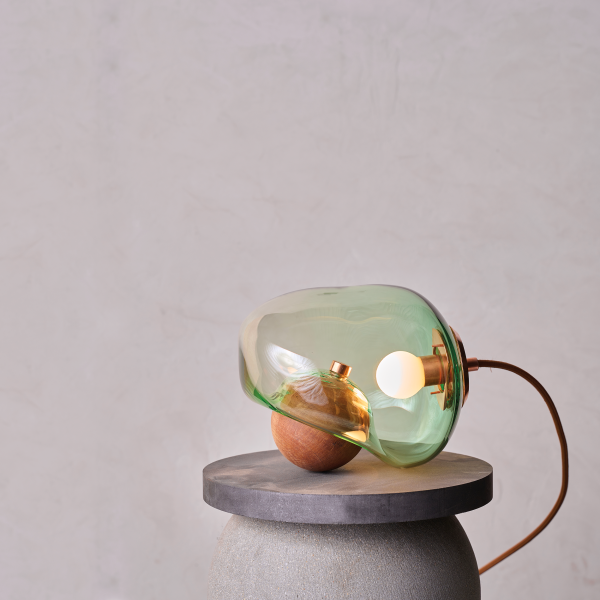
This 2023 table lamp is from the Ontologia collection and is made of aluminum, brass, and mahogany-stained birch, 9.5 x 10 x 10.25 in. Photo by Graham Tolbert.
Prospect Refuge + Hennepin Made
“Lighting is the jewelry of the home,” says Victoria Sass, whose Minneapolis-based interior design firm, Prospect Refuge, recently collaborated on the Ontologia collection with local lighting studio Hennepin Made.
Sass bonded with Hennepin founder Jackson Schwartz over the vicissitudes of the Midwestern climate, where winter days are long on darkness and short on natural light. To create the table lamp (floor and hanging iterations are available), artisans blow Swedish glass so that it appears to melt over—and partially encase—a wooden orb, which offers structural stability. Rather than something to be hidden, the cord is extra long by design—it can be looped, knotted, or left to trail. “Ontologia bridges that delicate place between function and form,” says Sass. “Is it art? Is it design? Is it craft?” All of the above.
hennepinmade.com | @hennepinmade
prospectrefugestudio.com | @prospectrefuge
Carmen D’Apollonio
You would not be surprised to see one of Carmen D’Apollonio’s ceramic or bronze lamps stand up, stretch, shimmy, or slither away. Hovering somewhere between sculpture and lighting, figurative and abstract, funny and poignant, the anthropomorphic figures thrum with life and humor (as do their titles). “Each lamp has its own character and personality, just like a little person,” affirms D’Apollonio, a Swiss-born, self-described studio potter based in Los Angeles.
D’Apollonio employs the coil method and mixes her own glazes for the one-of-a-kind ceramic bases, which are fired in her walk-in kiln. Bronze lamps are available in editions of eight, and shades are custom made to suit each piece.
carmendapollonio.com | @carmendapollonio

Carmen D’Apollonio’s I will come back if you let me, 2022, ceramic, linen shade, 44 x 41 x 20 in. Photo by Stephen Busken, courtesy of Friedman Benda and Carmen D’Apollonio.
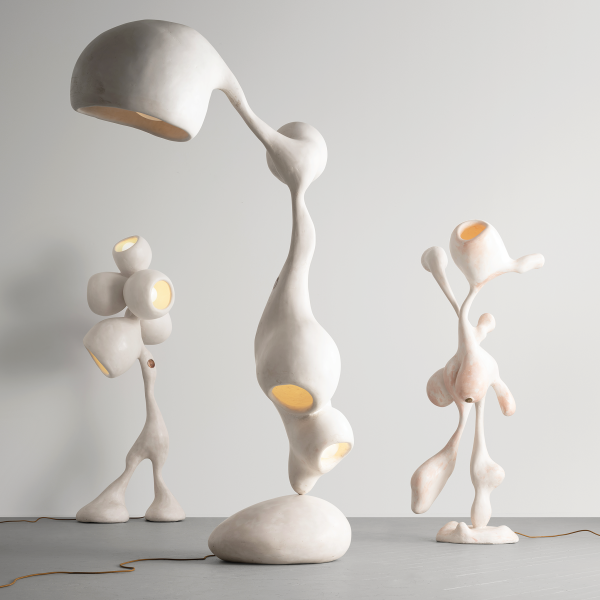
Rogan Gregory’s gypsum lamps including (left to right) Loe Depositor, 2022, 66 x 31 in.; Ovorepository, 2022, 91 x 24 in.; and Tiny Dancer (Ballerina), 2022, 68 x 18 x 22 in. Photo by Joe Kramm, courtesy of R & Company.
Rogan Gregory
Malibu, California–based furniture designer Rogan Gregory seeks to soften the tyranny of slick, rectilinear interiors with biomorphic forms rendered in such tactile materials as gypsum, terrazzo, ceramic, bronze, sheepskin, and cowhide. The illuminated sculptures from his Fertility Form series reflect Gregory’s interest in organic shapes and ecological systems. Like a mash-up of Dr. Seuss and Isamu Noguchi, his lamps might variously suggest an exotic plant life sprouting from the ground or dangling from the ceiling, or—as with these gypsum floor lamps—fantastical creatures come to life in the living room. The opposite of static, they shed light in multiple directions with an expressive abandon that invites interaction. Gregory has stated that by introducing such objects into our environments, he hopes to spur visceral emotions, such as joy and awe, and to help foster a deeper connection to the natural world.
r-and-company.com | @rogangregory
Katie Stout
A bumper crop of produce makes up Fruit Lady (Gold), one of Katie Stout’s collection of ceramic Lady Lamps, which shed light on prevailing standards of beauty, luxury, and femininity. With cartoonish bravado, this towering lamp alludes to the decorative arts, female-centric craft traditions (such as pottery), and art history—Giuseppe Arcimboldo’s 16th-century portraits and the scale and exuberance of Niki de Saint Phalle’s sculptures, for example—not to mention Carmen Miranda’s tropical fruit–filled hats.
Stout has observed that her work treads the line “between beauty and vulgarity,” which is expressed through her unabashed embrace of kitsch. Candy-colored fruits and vegetables are beaded onto the welded limbs of the Lady, whose arms hoist a gilded bushel-basket shade. Viewers are invited to touch as well as look: the on-off switch is embedded in a piece of fruit that serves as a breast, forming a sort of nipple.
katiestout.com | @ummmsmile

Katie Stout’s Fruit Lady (Gold), 2020, ceramic, paint, glaze, and gold luster, 71 x 32 x 17 in. Photo courtesy of Nina Johnson, Miami.
Alison Berger
As a child in Texas, Alison Berger delighted in collecting fireflies in glass jars—early prototypes for her future métier. Today, Berger’s handblown lamps are made in her Los Angeles–based shop, where she favors personal expression over mass production.
The Word Pendant was inspired by a 16th-century ceremonial glass chalice upon which members of a secret Austrian society scratched their names in script. In Berger’s modern interpretation, the shade is etched with translated excerpts from Leonardo da Vinci’s sketchbooks. When shone on a wall, shadows reveal the text backwards—an allusion to the artist’s practice of writing from right to left. Not intended as primary illumination, Berger’s lamps glow with low-watt Edison bulbs, “like electric candlelight,” she says. Or like a firefly in a mason jar on a balmy summer night.
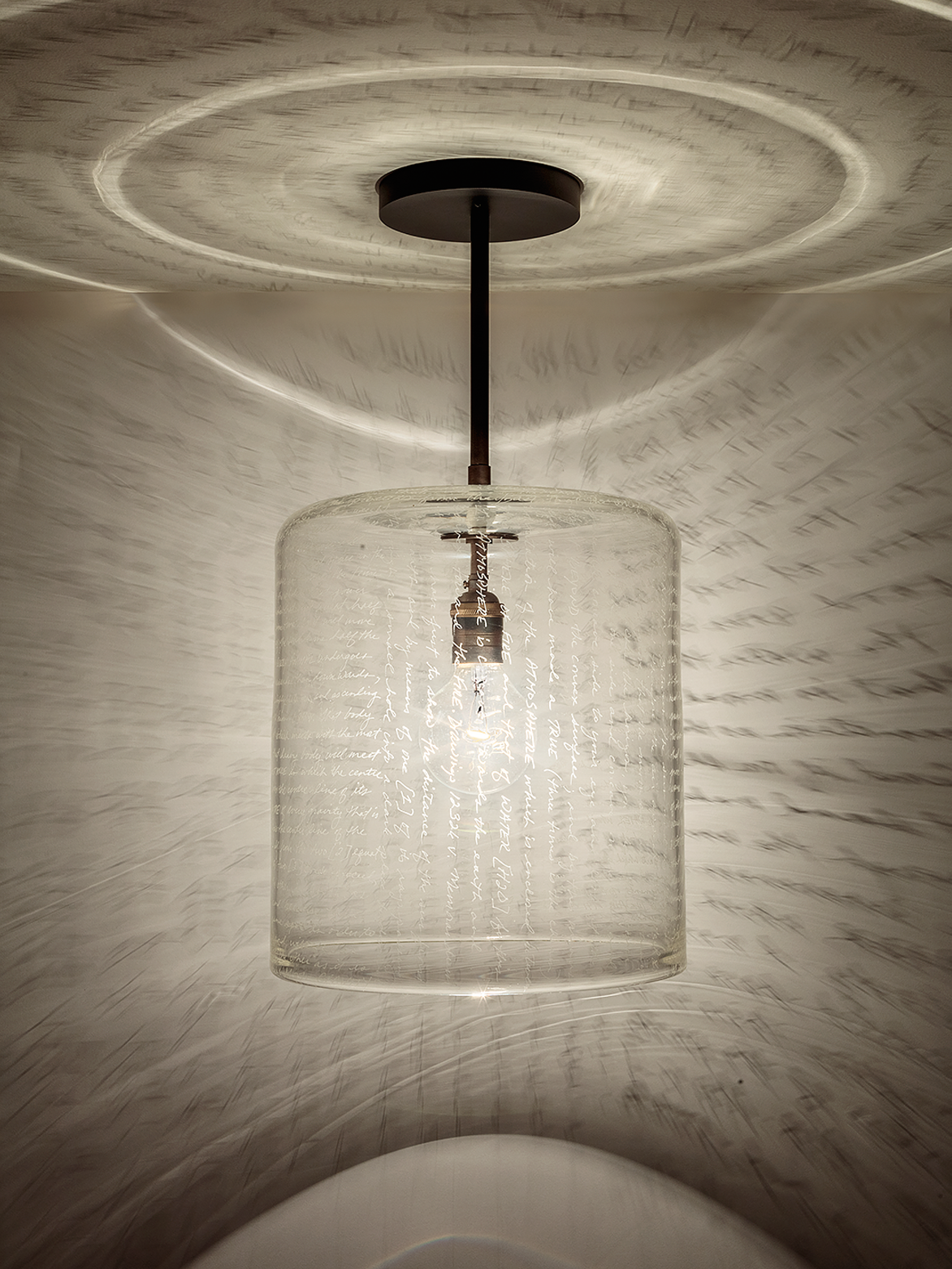
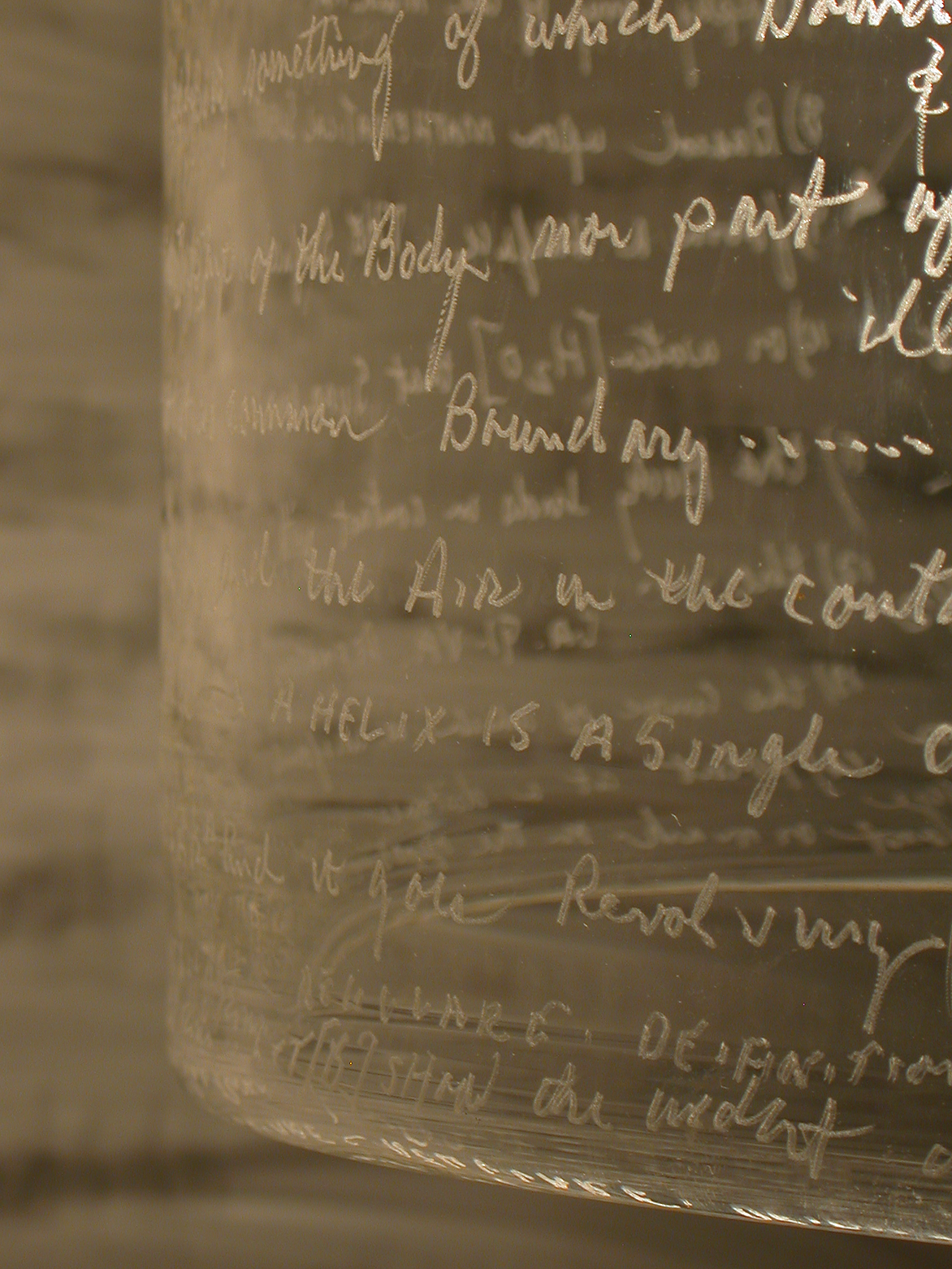
Adhi Nugraha
Indonesian product designer, teacher, and researcher Adhi Nugraha is serenaded in his West Java town by the mooing of cows and surrounded by the pungent odor of dung—a major polluter of local waterways. His search for a sustainable solution led Nugraha to devise a method for turning bovine excrement into a viable building material, while providing farmers with additional income.
When the cleaned, dried, and powdered dung is mixed with an adhesive, it can be molded into any number of useful items; these accent lamps honor their origins by suggesting stylized steer horns. The texture is similar to papier maché, and the aroma is neutralized by the inclusion of such waste materials as coffee grounds, cigarette butts, and clove leaves.
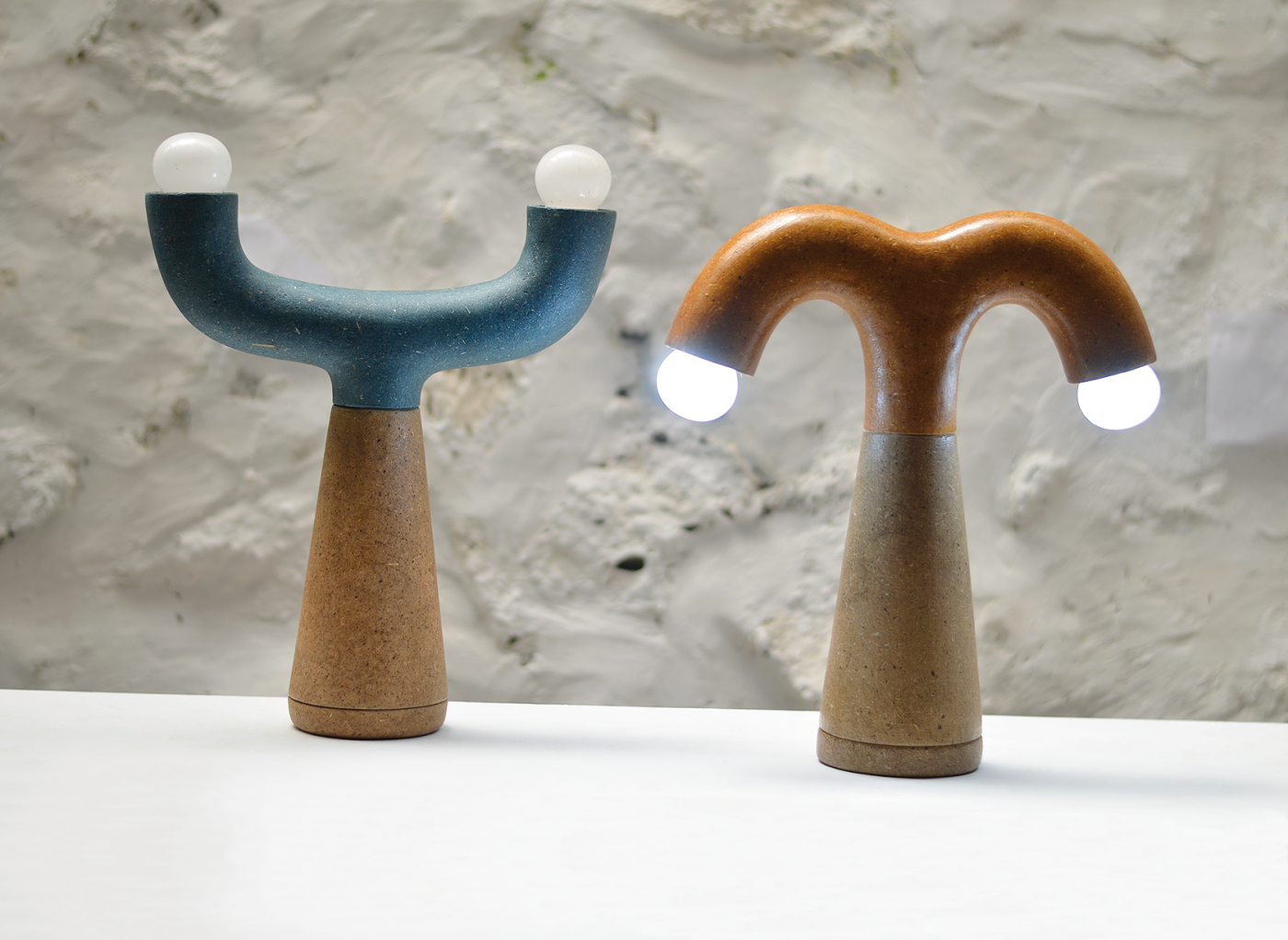
Adhi Nugraha’s Cow Dung Lamp 1 (right), 2021, 16.75 x 14.5 x 5.25 in. and Cow Dung Lamp 2 (left), 2021, 18.5 x 14.5 x 5.25 in., are both made of processed cow dung, PVA glue, and electronics. Photo by Adhi Nugraha.
Feyza Kemahlioglu
Although based in New York, the Istanbul-born Feyza Kemahlioglu looks homeward for material inspiration. Her Pillars of Meerschaum lighting collection incorporates meerschaum, a heat-resistant soft white clay mineral found mainly in central Turkey’s Eskişehir province, which artisans have carved since the 18th century. When the lamp is switched on, light animates the intricate floral and graphic patterns etched into the meerschaum tubes.
In conceiving her Sunset Drive pendants, Kemahlioglu sought to create an interplay of light and shadow. “I had an image of driving along at sunset, enjoying the cloud formations and the flashing of car headlights passing by,” recalls Kemahlioglu. The clay tubes are interspersed with handblown mirrored glass cylinders and sandblasted glass globes, which emit a soft glow “like the haze that sets in right before nightfall.”

Feyza Kemahlioglu, Sunset Drive, 2021, carved meerschaum tubes, brass, blown glass, and LEDs, 132 x 120 x 72 in. Photo by Galina Kurlat.
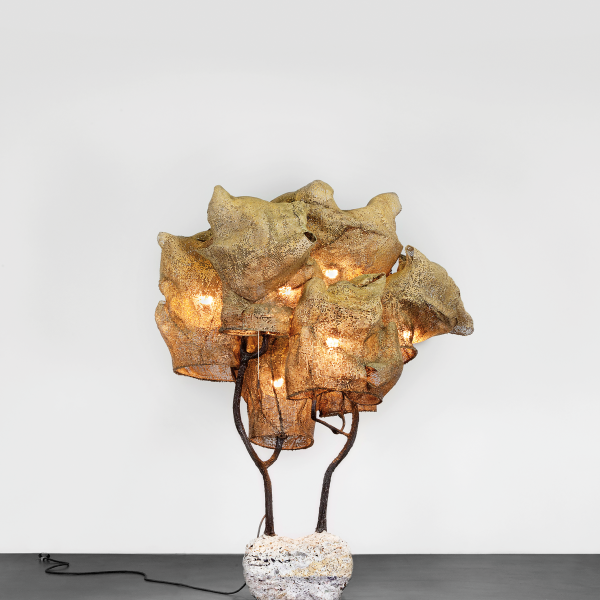
Nacho Carbonell’s Floor Lamp Concrete Base 5 (36/2016), has a concrete base, welded metal branches, and a shade made of metal mesh with textile hardener and pigments, 87 x 65 x 55 in. Photo courtesy of Carpenters Workshop Gallery.
Nacho Carbonell
“I like to see objects as living organisms capable of coming alive and surprising you,” says Nacho Carbonell of his sculptures, which include an array of Light Mesh lamps from his Cocoon series.
Glowing from within, the semitransparent clouds appear to billow up and around supportive metal trunks and branches like a tree canopy, creating a spectral dreamscape that helps evoke the Valencian topography of Carbonell’s youth (he now resides in Eindhoven, Netherlands). The artist hand-works the steel mesh around a frame, then treats each cocoon with a plasterlike material of his own composition (which includes paper pulp, sand, Paverpol, and pigments). At once futuristic and nostalgic, the work has been described by Carbonell as growing out of—and giving shape to—his personal memories, which he poetically compares to excavated fossils.





